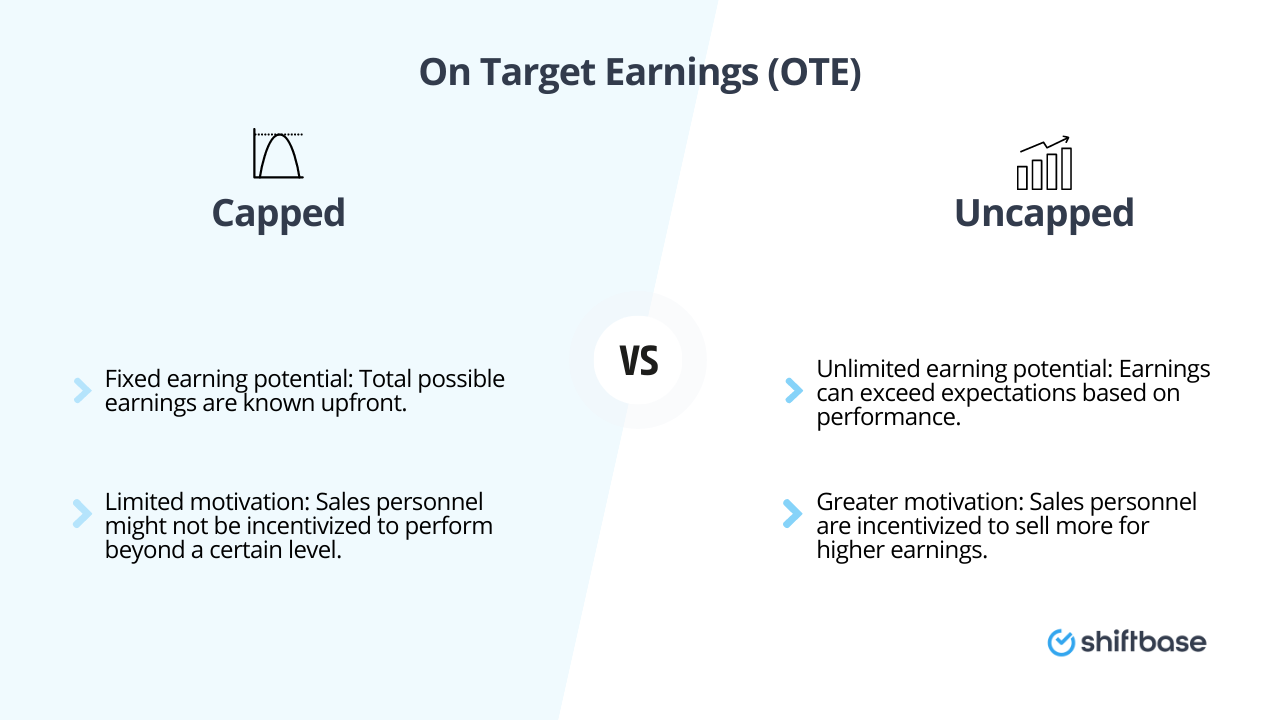In this article, we aim to uncover the vital role of on target earnings have in decoding your compensation structure, enhancing employee engagement, and hitting those vital sales quotas.
What are on-target earnings?
On-target earnings, aka On-track earnings or OTE, is the total expected compensation a sales rep or account executive can earn when meeting their performance targets or sales quota. It represents the sum of an employee's base salary and the commission they earn from sales.
There are two key elements in OTE:
-
Base salary: This is the fixed yearly base salary that an employee earns, irrespective of their sales. It's a stable part of the sales rep's pay, providing financial security.
-
Commission: This is a performance-based reward, often a percentage of the total sales. Commissions encourage sales reps to exceed their monthly or annual sales quota, motivating them to contribute to the sales process more effectively.
.png?width=1024&height=768&name=On%20Target%20Earnings%20(OTE).png)
How is OTE calculated?
Calculating OTE involves adding the base salary and the potential commission one can earn to meet their sales quota. It's an expected total pay, not a guarantee. The actual commission may vary based on a sales rep's performance and the sales organization's policies.
For example, if an account executive has an annual base salary of $60,000 and an annual commission potential of $40,000, their OTE is $100,000. It's also important to note that the pay mix (base salary to commission ratio) can significantly influence the OTE figure.
The importance of on-target earnings
The Role of OTE in sales compensation plans
OTE is a cornerstone of sales compensation plans. It helps sales managers and hiring managers define competitive compensation packages that attract and retain top talent. Here are three reasons why OTE is a critical component:
-
Transparency: OTE provides clear insights into the potential earnings, which gives sales reps a clear understanding of what their effort could yield.
-
Benchmarking: It allows hiring managers to compare their compensation plan with the market average, ensuring their package remains competitive.
-
Planning: It aids sales organizations in budgeting and planning their total annual sales quota, ensuring they meet their overall business goals.
The motivation factor: How OTE influences sales performance
OTE plays a crucial role in motivating sales employees or representatives to perform at their best. Here's how:
-
Goal-setting: By attaching a tangible reward to sales targets, OTE encourages sales reps to set ambitious goals and strive to achieve them.
-
Engagement: OTE keeps the sales team engaged and motivated throughout longer sales cycles by offering performance-based incentives.
-
Rewarding excellence: High-performing sales reps can earn significantly above their base salary, which rewards their efforts and motivates them to maintain their performance levels.
Impact of OTE on employee retention and job satisfaction
OTE can influence job satisfaction and employee retention in a few key ways:
-
Financial stability: The base salary component of OTE offers financial stability, which can enhance job satisfaction.
-
Performance recognition: The commission part of OTE provides recognition for hard work and successful sales, which can boost employee morale and engagement.
-
Competitiveness: A well-structured OTE package can make a sales representative role more attractive, leading to higher retention rates among sales teams.
Capped vs. uncapped OTE

One of the most critical decisions in structuring an OTE plan is choosing between capped and uncapped commission structures. Each has its unique benefits and considerations.
Capped OTE
In a capped OTE structure, there's a maximum limit to the commission a sales rep can earn, regardless of how much they sell. Organizations often use this to control costs and manage budget expectations. However, a capped commission can potentially demotivate sales reps who hit their ceiling early, as they might need to see a reason to push for more sales once they reach their cap.
Benefits of capped OTE:
-
Budget control: Capping commissions allows a company to monitor its budget by preventing unexpectedly high payouts.
-
Equitable earnings: A cap can ensure a more equitable distribution of earnings among the sales team, especially if there are limited leads or opportunities.
-
Consistent profit margins: By limiting the commission paid out, companies can maintain consistent profit margins even if sales reps significantly exceed their quotas.
Uncapped OTE
On the other hand, an uncapped OTE structure offers unlimited earning potential for sales reps, meaning the more they sell, the more they earn. This model can motivate high-performing reps to surpass their sales targets.
Related: 10 High performer Characteristics: How to identify high performers in your team
Benefits of uncapped OTE:
-
Unlimited earnings: The prospect of limitless earnings can be a strong motivator for sales reps, potentially leading to higher sales and revenue for the company.
-
Competitive advantage: Offering uncapped commissions can give companies a competitive edge in attracting and retaining top talent in the sales industry.
-
Performance recognition: Uncapped OTE can clearly recognize high performance, boosting morale and job satisfaction among top-performing sales reps.
Choosing between capped and uncapped sales, OTE largely depends on your sales organization's specific needs, objectives, and resources. By understanding the advantages and potential challenges of each, you can make an informed decision that best supports your team and business goals.
The role of on-target earnings in different industries
OTE structures can vary significantly across industries. Here's a closer look:
Variation in OTE across industries
The base salary may constitute a larger portion of the OTE in some industries with longer sales cycles, such as tech. In contrast, industries with shorter sales cycles, like real estate, might offer a lower base salary but a higher commission percentage.
Examples of OTE structures in different industries
The average OTE might be split 50/50 between base salary and commission in the tech industry. On the other hand, in the pharmaceutical industry, the split might lean more heavily toward base salary due to the long and complex sales process. In real estate, the balance could tip towards commissions due to quick turnovers and high-value deals.

Employee scheduling and Time-tracking software!
Potential pitfalls and challenges with on-target earnings
While OTE can certainly drive motivation and performance, it isn't without its challenges. Recognizing these potential pitfalls is the first step in addressing them effectively.
Difficulty in setting realistic targets
Determining the right sales quotas can be tricky. If the targets are too high, they seem unattainable and demotivate sales reps. Conversely, they may not sufficiently challenge your team or drive business growth if they are too low.
Incorrect OTE structured resulting in decreased morale and productivity
An incorrectly structured OTE plan can create clarity and satisfaction. For instance, a plan heavily weighted towards commission can create financial instability for sales reps, negatively impacting morale and productivity.
The risk of overemphasizing sales at the expense of other important work
When not properly managed, OTE can lead to overemphasizing sales, potentially neglecting other critical tasks like customer relationship management or strategic planning. A balanced approach is necessary to ensure all areas of the business thrive.
Strategies for implementing effective on-target earnings plans
 A well-structured and thoughtfully implemented OTE plan can do wonders for your sales organization. Here are a few strategies to help you optimize your OTE plan:
A well-structured and thoughtfully implemented OTE plan can do wonders for your sales organization. Here are a few strategies to help you optimize your OTE plan:
Balancing base salary and commission
Striking the right balance between base salary and commission is key. While the base salary offers stability, the commission serves as motivation. Depending on the nature of your industry, sales cycle lengths, and the average attainment of sales reps, you may need to adjust this balance for the most effective OTE.
Setting clear, achievable targets
Setting sales targets that are challenging yet achievable can motivate your sales representatives without overwhelming them. It will also increase average rep earnings. These targets should be communicated and consistently monitored to align with business objectives and market realities.
Regular review and adjustment of OTE plans
An OTE plan should be flexible. Regularly reviewing and adjusting the plan based on business needs, market conditions, and sales reps' performance can help maintain its relevance and effectiveness.
Conclusion
On-target earnings are a powerful tool in any sales leader's arsenal. Understanding its nuances, being aware of potential challenges, and implementing effective strategies can significantly improve your sales team's performance and job satisfaction.
How Shiftbase Fits into Your OTE Calculation
When considering On Target Earnings (OTE), it's essential to consider how you're managing your workforce. Efficiency in employee scheduling, accurate time tracking, and proper absence management are all vital aspects that contribute to achieving your sales quotas.
Here's where our software, Shiftbase, comes into play. Shiftbase is a SaaS product designed to optimize your workforce management. By providing precise employee scheduling and time tracking, it ensures that your team is on target with their sales performance. Plus, its comprehensive absence management feature makes it easy to keep track of who's in and who's out, which directly influences your sales outcomes.
In essence, Shiftbase supports your team in hitting their OTE and exceeding their sales targets.
Ready to boost your sales performance? Try Shiftbase free for 14 days and experience the benefits first-hand. Get started today by signing up here.

.png?width=1024&height=768&name=On%20Target%20Earnings%20(OTE).png)


 A well-structured and thoughtfully implemented OTE plan can do wonders for your sales organization. Here are a few strategies to help you optimize your OTE plan:
A well-structured and thoughtfully implemented OTE plan can do wonders for your sales organization. Here are a few strategies to help you optimize your OTE plan:
